He’s a water-breathing strongman from the ocean’s depths, he’s the rightful king of Atlantis, and he’s often been allied with some of Earth’s most powerful superheroes.
And he’s not Aquaman.
DC’s Aquaman may get better publicity, but the original, accept-no-substitutes undersea hero is Marvel Comics’ Prince Namor, the Sub-Mariner, who first appeared a full two years before Aquaman, way back in 1939. Not only did Namor come first, he’s also hands down a far more interesting character, mostly because he can be such an insufferable bastard. Let’s take a look now at the up-and-down publishing history of Namor, unquestionably comics’ first real anti-hero.
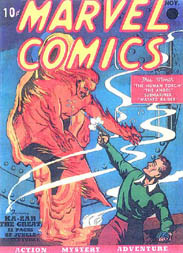
Sub-Mariner first appeared in Timely’s first comic book, MARVEL COMICS #1 (October 1939), although the story had earlier seen print in a black-and-white movie-theatre giveaway entitled MOTION PICTURES FUNNIES WEEKLY #1. Regardless, MARVEL COMICS #1 was Namor’s first nationwide exposure. The same can be said for Timely’s other early superhero success from that issue, the Human Torch, whom we’ll get back to shortly.
The debut story, entitled simply “The Sub-Mariner,” was written and drawn by Bill Everett, and, compared to many of the crude, simplistic strips being published in many comics of the time, is a lavishly illustrated wonder. Everett had a fully rendered, almost cinematic style which blows away most of his contemporaries. Small details, like the light, gray-toned lines to indicate the visual distortion that accompanies the underwater scenes, or the ever-shifting hairstyle of Namor, serving as a continued reminder that he’s underwater.

The story opens with the curious account of a deep-sea salvage diver, convinced that someone or something had beaten them to a shipwreck. More divers are sent down to investigate, where they encounter a man swimming at crushing depths without pressure suit or oxygen helmet. The swimmer, mistaking the divers in their heavy suits for some sort of mechanicals, cuts their oxygen lines to the surface.
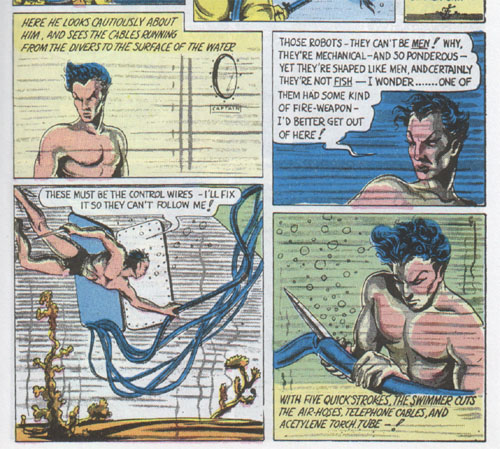
He then attacks the frightened divers, killing them both. When another diver descends to investigate, he sees the bodies of his shipmates and swims for his life, returning to the ship.

When the swimmer sees the ship beginning to leave, he grips the ship’s rudder and propeller with his bare hands, and gives the boat a mighty shove, launching it into the air, shattering on the rocky shore.
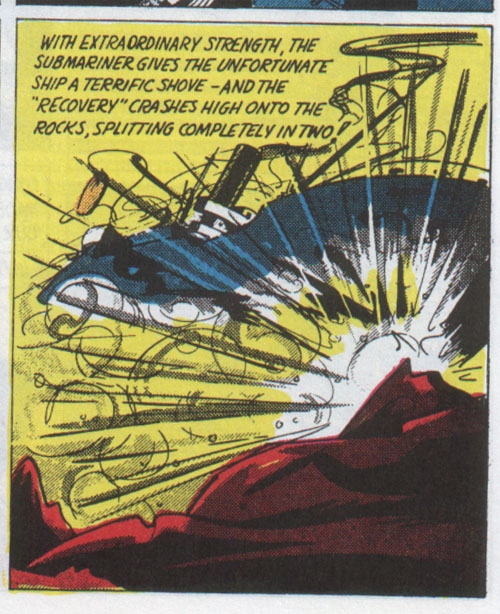
The swimmer then retrieves the bodies of the murdered divers and takes them to an undersea grotto, where he enters a royal chamber. Here Namor brings his prize, showing off the pressure-suited corpses and boasting of his destruction of a surface-dweller’s ship.
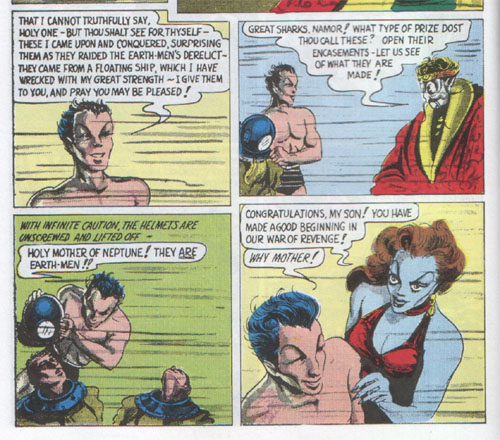
Only after removing the helmets does Namor realize that the divers were in fact men, and it is then that we meet Namor’s mother Fen, who explains to him and us how Namor came to be.
Fen, the Atlantean Princess, was sent to the surface as a spy to investigate the inadvertent bombing of Atlantis by a scientific vessel, the Oracle, captained by Commander Leonard McKenzie.

Fen stowed away aboard the ship, and soon she and McKenzie fell in love and were married; all the while Fen continued to report back to the Atlanteans in secret. Despite her warnings, the Atlanteans marshaled for a counter-attack, but were all but destroyed by another bombardment from above, leaving only a few remaining. With the birth of Namor came the Atlanteans’ last chance for revenge, since his human-Atlantean heritage means he is the only one who can live both on the land and in the water, as well as fly through the air, thanks to wings sprouting from his ankles, an accident of birth (making the Sub-Mariner Marvel’s first mutant by about 25 years). With that, Namor, the Avenging Son, takes off for the surface, set on avenging the injustices done to his people.
This was a series ahead of its time. Both in the subtleties of its story and the slickness of the illustration, this doesn’t feel like a story created in 1939. Here we have a situation where the protagonist is clearly in the right, yet his sworn enemy is America. This kind of duality in sympathy wasn’t at all common in the popular art of the time, and yet here’s a comic-book hero who hates America, and he’s not altogether wrong. As for the artwork, Everett’s moody style feels far more adult and realistic than many other strips of the day, yet Everett isn’t afraid to venture into the cartoony with the decidedly fishlike appearances of the male Atlanteans. As for Princess Fen, she’s just human enough to remain attractive, while retaining the distinctive upswept eyebrows, large fisheyes and blue skin of the male Atlanteans.
The next few issues of MARVEL MYSTERY COMICS (so the series was renamed as of issue #2), featured Namor going on a tour of destruction above in the surface world, focusing on New York City, and even betraying a bit of affection for a human woman, New York Policewoman Betty Dean. The peak of Namor’s uncontested rampage came in MARVEL MYSTERY COMICS #7, in which Namor plans to destroy the entire North American continent, using New York as his base of operations. Symbolically enough, Namor begins his campaign at the Statue of Liberty, not only attacking a guard upon his arrival, but also flying up to the torch and throwing tourists out the window. That, my friends, is a bold statement.

When the Coast Guard arrives and attacks, Namor pushes the Coast Guard ferry directly into the path of a giant cruise liner and, well, you can guess the rest…

Looking to establish a more direct line of communication with the human race, Namor flies to City Hall and slaps around the mayor, just to get his attention.

When the mayor calls out the National Guard to deal with Namor, the Avenging Son cranks it up a notch, first destroying an elevated train (fully occupied, mind you) …

…then flying to the top of the Empire State Building, ripping off the skyscraper’s spire and throwing it to the busy streets below.

Only a plea for mercy from Betty Dean turns away Namor’s wrath, and even then, her warning that the Human Torch would soon be coming after him is met with a defiant “Let him come!”
Human Torch, you ask? Indeed, and I’m not talking about Johnny Storm, either. With your indulgence, a brief digression on the Torch. As mentioned earlier, the Torch premiered in the same issue as Namor, MARVEL COMICS #1. However, where Everett’s SUB-MARINER strip was lushly illustrated, the Torch’s first appearance, written and drawn by Carl Burgos, was crude even by the rough standards of the time. It must have been just the sheer visual novelty of the protagonist, a man completely engulfed in flame, that accounted for the early success of the series. The Torch was actually an android, a synthetic man created by Professor Phineas Horton, but not without some difficulty: to be exact, the slightest contact with oxygen would make Horton’s artificial man burst into flame.

After the media and his fellow scientists condemn Horton’s creation, he agrees to seal up the android in a concrete tomb. There the Torch stays, until a slow leak allowed oxygen to seep into his tomb, granting the Torch the necessary fuel to set himself aflame and burst free.
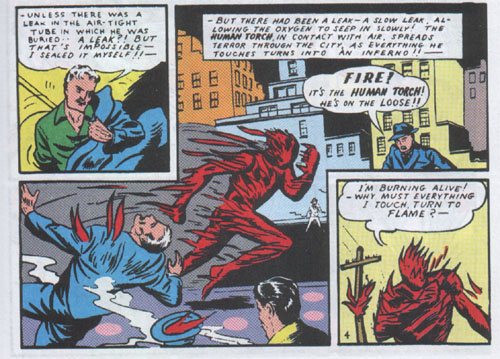
The self-aware and remorseful Torch runs through the city, trying to control his flame, while firemen desperately try to contain his blaze. The naive Torch winds up being manipulated by criminals who use him in a protection racket, and in his efforts to catch the extortionists, he learns that his flame powers give him the ability to fly, and also learns to control his flame completely.

The Torch abandons his creator, who had hoped to use him for profit, and eventually takes on the name Jim Hammond and is granted quasi-official status with the Police Department. Which is about where we left off with our friend Namor…
MARVEL MYSTERY COMICS #8 featured the first real dust-up between Namor and the Torch, one of several to come in succeeding months. In an innovative concept, the issue featured separate Torch and Namor stories that featured their own perspective of the same events. It’s interesting how much Burgos’ art has improved over the months between the Torch’s debut and this issue; whether Burgos was inspired or merely had the resources now to hire assistants is unknown. Interestingly, in this issue the Torch busies himself with repairing some of the damage down by Namor the previous month, specifically the elevated train crash.

Following that, the Torch heads for the Empire State Building and helps free some innocent civilians trapped beneath the spire that Namor had thrown to the ground. (This level of continuity was unprecedented in comics of the 1940s, by the way…)
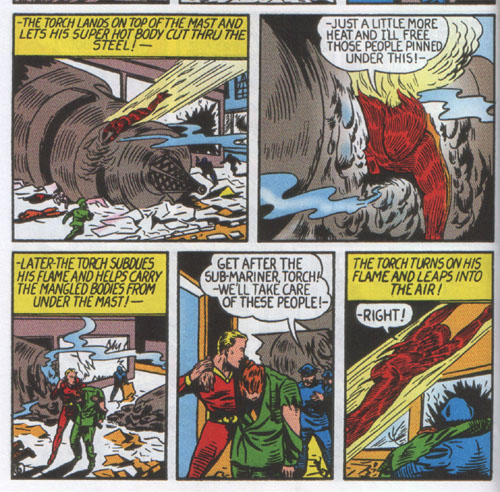
Eventually, Namor and the Torch come to blows atop the George Washington Bridge, but soon adjourn to their separate corners.

In the following issue, Namor and Sub-Mariner battle it out in a 22-page-long war, peaking with an infamous scene where Namor, with the help of a school of whales, unleashes a tsunami upon New York City. The creation of the issue is equally legendary, as Everett and Burgos, with the help of a few friends and assistants, reportedly turned the issue out over one long weekend, with artists working on pages in every available space in their tiny flat, with one fellow even working in the bathtub.
It wouldn’t be long before the march of war would put an end to the antagonism between Sub-Mariner and the Human Torch. After all, if there’s one thing Namor hates more than surface-dwellers, it’s Nazi surface-dwellers.
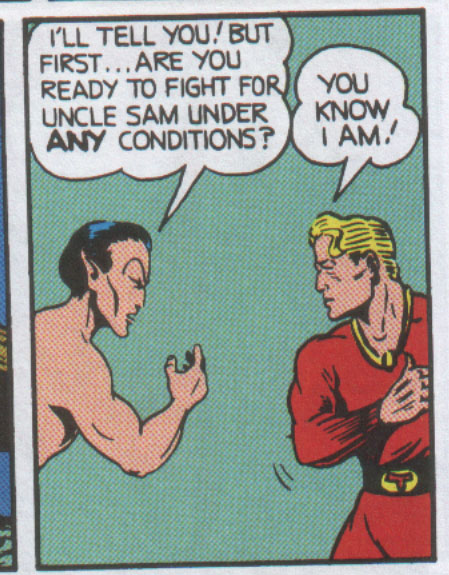
In MARVEL MYSTERY COMICS #17 (March 1941), Namor returns to New York to gain the Torch’s help in stopping a Nazi plot to dig a tunnel beneath the Pacific Ocean, under the Bering Strait. With the help of Namor’s small fleet of Atlantean submarines, Sub-Mariner and the Torch manage to destroy the tunnel, as well as a small army of Japanese and Nazi troops and armor.

Namor and the Torch manage to work together quite well, although they can’t resist a few snipes at each other along the way.

Still, by adventure’s end, both Namor and the Torch have saved each other’s lives, and it seemed that a new era of cooperation had been ushered in.
Namor’s Nazi-busting continued throughout the war, taking place in his solo adventures as well, such as in “Terror of the Boiling Seas,” from MARVEL MYSTERY COMICS #42 (April 1943). Here Namor thwarts a Nazi plot to raise the temperature of the ocean to near-boiling, sinking ships and murdering hundreds of Allied sailors.

Namor discovers the heating discs responsible for the atrocity, and after duking it out with the Nazi commandant behind the operation, sabotages the equipment so that the heating discs boil the Nazi command sub instead.
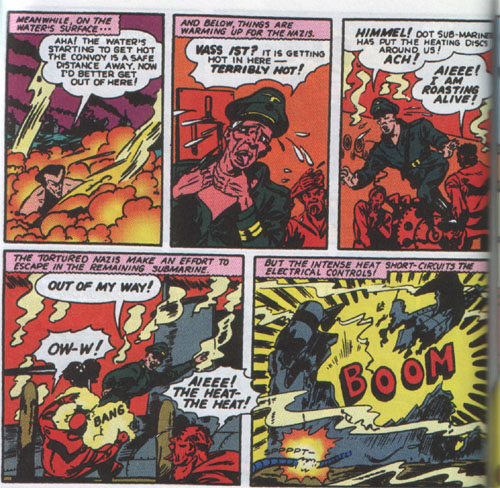
The end of the war took quite a toll on the popularity of Timely’s heroes, much more so than their rivals at DC (probably because unlike Superman and Batman, who just kind of dabbled in Nazi-hunting, Timely’s heroes were so identified with the war effort that their adventures in peacetime seemed a little pointless), and by 1949, Sub-Mariner and the Torch had vanished from the pages of MARVEL MYSTERY, which had changed focus and become MARVEL TALES, a horror anthology.
Timely’s heroes got a bit of a reprieve four years later in 1953, when the success of THE ADVENTURES OF SUPERMAN on television prompted Timely honcho Martin Goodman to order his super-types out of mothballs. Accordingly, YOUNG MEN #24 (December 1953) featured the returns of Captain America, the Human Torch and Sub-Mariner. While the Cap and Torch stories were by all-new creative teams and generally busied themselves with affixing the World War II heroes firmly into a new Communist-bashing premise, the Sub-Mariner story was written and drawn by Namor’s creator Bill Everett, and took a more science-fiction-style approach.
When a series of commercial freight liners all mysteriously sink and are plundered near the same South Pacific island, Namor’s old friend Betty Dean tries reaching him to investigate the matter. It seems that after the war Namor returned to the South Pole to try and rebuild his empire, but after a simple phone call to the Navy, a dapper, well-dressed Namor is soon on Betty Dean’s doorstep, ready to help out the good ol’ U.S. of A. Even considering Namor’s wartime allegiances, this seems a little too chummy to be the same guy who was once tossing people overhand off the Statue of Liberty. Maybe he just really liked Betty Dean…
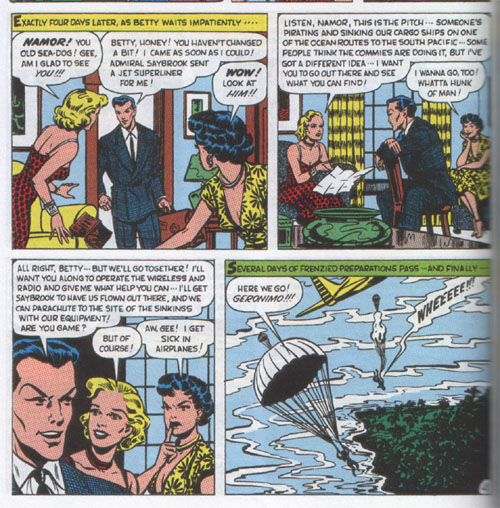
Anyway, so Namor and Betty head off to the South Pacific to investigate, and it turns out it’s not Commies that are sinking our ships, it’s robots. Robots from Venus. Namor plays possum and is brought before the Venusian robot leader, then traps the whole mess of robots, burying them inside their hidden cavern with a freighter’s worth of coal.

The robot leader deactivates himself, and when the authorities come to investigate, all sign of the Venusian robots are gone, leaving Betty and Namor alone with the knowledge of what really happened, while Namor looks to be getting a little grabby with ex-Policewoman Dean. Put some clothes on a guy, and suddenly he’s all hands…
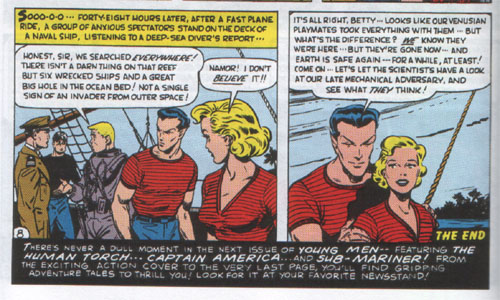
Namor, Torch and Cap appeared a few more times over the next year, with Sub-Mariner even receiving his own magazine again. Why the renewed push for Namor? As it turns out, the success of the George Reeves SUPERMAN TV series had prompted some TV producers to develop a SUB-MARINER series, which was reportedly to star B-movie actor Richard Egan, who’s probably best known for his turn in Walt Disney’s Hayley Mills vehicle POLLYANA. When plans for the TV series sunk to Davy Jones’ locker, so did Namor’s new comic book, and by 1955 Sub-Mariner was again abandoned, never to be seen again.
Well, not exactly never. This time, it would take a whole six years to bring Namor back.
But we’ll get to that next week.

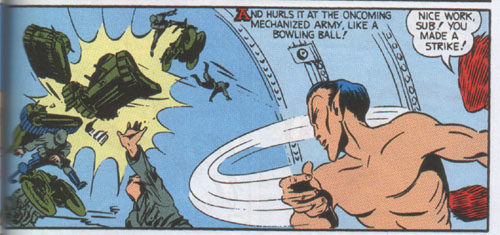
Comments are closed.